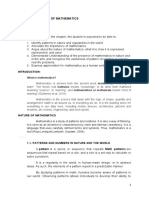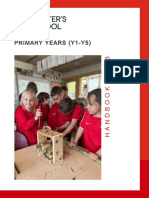0 ratings0% found this document useful (0 votes)
55 viewsLesson 1
Mathematics deals with patterns and relationships through numbers and operations. It helps organize ideas about patterns in nature. Symmetry occurs with congruent dimensions, proportions, and arrangements, providing a sense of harmony. Mathematics studies various natural patterns including symmetry, fractals, spirals, waves, cracks, and spots and stripes. These patterns repeat at different scales.
Uploaded by
Sherann ComaCopyright
© © All Rights Reserved
Available Formats
Download as DOCX, PDF, TXT or read online on Scribd
0 ratings0% found this document useful (0 votes)
55 viewsLesson 1
Mathematics deals with patterns and relationships through numbers and operations. It helps organize ideas about patterns in nature. Symmetry occurs with congruent dimensions, proportions, and arrangements, providing a sense of harmony. Mathematics studies various natural patterns including symmetry, fractals, spirals, waves, cracks, and spots and stripes. These patterns repeat at different scales.
Uploaded by
Sherann ComaCopyright
© © All Rights Reserved
Available Formats
Download as DOCX, PDF, TXT or read online on Scribd
You are on page 1/ 3
Mathematics - Symmetry occurs when there is
congruence in dimensions, due
- Mathematics is a branch of science,
proportions and arrangement. It
which deals with numbers and their
provides a sense of harmony and
operations.
balance.
- It involves calculations, computation,
- Symmetry in everyday language refers
solving of problems, etc.
to a sense of harmonious and beautiful
- Mathematics helps us to organize and
proportion and balance. In
systemize our ideas about patterns, in
mathematics, "symmetry" has a more
so doing, not only can we admire and
precise definition, and is usually used to
enjoy these patterns, we can also use
refer to an object that is invariant
them to infer some of the underlying
under some transformations; including
principles that govern the world of
translation, reflection, rotation or
nature.
scaling. Although these two meanings
- “Mathematics is a study of patterns and
of "symmetry" can sometimes be told
relationship, a way of thinking, an art, a
apart, they are intricately related.
language, and a tool. It is about patterns
and relationships. Numbers are just a Types of Symmetry
way to express those patterns and
Bilateral or reflection symmetry is the simplest
relationships.” — National Council of
kind of symmetry. It can also be called mirror
Teachers of Mathematics (1991)
symmetry because an object with this
Patterns and Numbers in Nature symmetry looks unchanged if a mirror passes
through its middle.
Pattern
Radial symmetry is rotational symmetry around
- A pattern is an arrangement which
a fixed point known as the center. Images with
helps observers anticipate what they
more than one lines of symmetry meeting at a
might see or what happens next.
common point exhibits a radial symmetry.
- A pattern also shows what may have
come before. Rosette patterns consist of taking motif or an
- Natural patterns include symmetries, element and rotating and/or reflecting that
fractals, spirals, meanders, waves, element. There are two types of rosette
foams, tessellations, cracks, and spots patterns namely cyclic and dihedral.
& stripes. Studying patterns allows one
Frieze pattern is a pattern in which a basic motif
to watch, guess, create, and discover.
repeats itself over and over in one direction. It
The present mathematics is
extends to the left and right in a way that the
considerably more than arithmetic,
pattern can be mapped onto itself by a
algebra, and geometry.
horizontal translation.
A. Symmetry 7 types:
- Symmetry can be found everywhere. It
can be seen from different viewpoints 1. Hop – only admits a translational
namely; nature, the arts and symmetry.
architecture, mathematics; especially 2. Step – only admits a translational and
geometry and science. glide symmetries.
3. Sidle – only admits translations and of circular shapes that revolve around
vertical reflections. it. Examples of spirals are pine cones,
4. Spinning Hop – only admits translations pineapples, hurricanes. The reason for
and 180◦ rotations (half-turns). why plants use a spiral form like the leaf
5. Spinning Sidle – only admits picture below is because they are
translations, vertical reflections, constantly trying to grow but stay
rotations, and glide reflections. secure.
6. Jump – only admits translations, a F. Meanders, flow, chaos
horizontal reflection, and glide - The relationship between chaos and
reflection. fractals is that strange attractors in
7. Spinning Jump – admits translations, chaotic systems have a fractal
vertical reflections, horizontal dimension. Meanders are bends in a
reflections, rotations, and glide sinuous form that appears as rivers or
reflections. other channels, which form as a fluid,
most often water, flows around bends.
Wallpaper pattern is a pattern with translation
Chaos is the study of how simple
symmetry in two directions. It is, therefore,
patterns can be generated from
essentially an arrangement of friezes stacked
complicated underlying behavior.
upon one another to fill the entire plane.
- Many events were considered to be
B. Tessellation – a tessellation is a pattern chaotic, unpredictable and random. The
of one or more shapes where the dripping of a tap, the weather, the
shapes do not overlap or have no space formation of clouds, the fibrillation of
between them. the human heart, the turbulence of
C. Waves – as waves in water or wind pass fluid flows or the movement of a simple
over sand, they create patterns of pendulum under the influence of a
ripples. When winds blow over large number of magnets are a few examples.
bodies of sand, they create dunes, G. Spots, Stripes
sometimes in extensive. - Leopards and ladybirds are spotted;
D. Fractals angelfish and zebras are striped.
- Fractals are never-ending patterns. The - These patterns have an evolutionary
beauty of fractals is that their infinite explanation: they have functions which
complexity is formed through the increase the chances that the offspring
repetition of simple equations. These of the patterned animal will survive to
repeating patterns are displayed at reproduce.
every scale. - One function of animal patterns is
- A fractal is a kind of pattern that we camouflage; for instance, a leopard that
observe often in nature and in art. As is harder to see catches more prey.
Ben Weiss explains, “whenever you H. Cracks
observe a series of patterns repeating - Cracks are linear openings that form in
over and over again, at many different materials to relieve stress. When a
scales, and where any small part material fails in all directions it results in
resembles the whole, that’s a fractal. cracks. The patterns created reveal if
E. Spiral – A spiral is a curved pattern that the material is elastic or not.
focuses on a center point and a series
- Cracks are overlooked because they are
so common. It is often a pattern
engineers want to avoid, for example a
crack in a bridge or a road or a glass.
Engineers spend a lot of time trying to
determine when a crack can become a
catastrophe.
I. Foam & Bubbles
- Foam is a mass of bubbles; foams of
different materials occur in nature.
- A foam is a substance made by
trapping air or gas bubbles inside a
solid or liquid. Typically, the volume of
gas is much larger than that of the
liquid or solid, with thin films separating
gas pockets.
- Bubble is a spherically contained
volume of air or other gas, especially
one made from soapy liquid while foam
is a substance composed of a large
collection of bubbles or their solidified
remains.
You might also like
- Chapter 1 Mathematics in Our World For PDF 1No ratings yetChapter 1 Mathematics in Our World For PDF 128 pages
- Mathematical Pattern and Numbers in NatureNo ratings yetMathematical Pattern and Numbers in Nature10 pages
- LESSON-1-PATTERNS-AND-NUMBERS-IN-NATURE-AND-THE-WORLDNo ratings yetLESSON-1-PATTERNS-AND-NUMBERS-IN-NATURE-AND-THE-WORLD30 pages
- Mathematics in The Modern World: GEED 10053No ratings yetMathematics in The Modern World: GEED 1005355 pages
- "The Laws of Nature Are But The Mathematical Thoughts of God" - Euclid100% (1)"The Laws of Nature Are But The Mathematical Thoughts of God" - Euclid44 pages
- Mathematics in The Modern World Lesson 1No ratings yetMathematics in The Modern World Lesson 123 pages
- Mathematics in The Modern World - Module 1No ratings yetMathematics in The Modern World - Module 14 pages
- A.) Bilateral Symmetry: A Symmetry in Which: Patterns and RegularitiesNo ratings yetA.) Bilateral Symmetry: A Symmetry in Which: Patterns and Regularities2 pages
- GE 4 MODULE 1 The Nature of MathematicsNo ratings yetGE 4 MODULE 1 The Nature of Mathematics44 pages
- The Nature of Mathematics: Natural PatternsNo ratings yetThe Nature of Mathematics: Natural Patterns12 pages
- Day Wise Lesson Plan I To VIII Maths SymmetryNo ratings yetDay Wise Lesson Plan I To VIII Maths Symmetry5 pages
- 11 Free Christmas Crochet Patterns For Your Home Ebook100% (5)11 Free Christmas Crochet Patterns For Your Home Ebook44 pages
- Design and Application of Splicing Patterns BasedNo ratings yetDesign and Application of Splicing Patterns Based4 pages
- Elements and Principles WRT Colors in InterioNo ratings yetElements and Principles WRT Colors in Interio22 pages
- From Line To Landscape: Studio Problem IiNo ratings yetFrom Line To Landscape: Studio Problem Ii3 pages
- Mathematical Monotheism - THE GENESIS 1 - 1 MIRROR CODENo ratings yetMathematical Monotheism - THE GENESIS 1 - 1 MIRROR CODE34 pages
- Digital 3D Design As A Tool For Augmenting Zero-WaNo ratings yetDigital 3D Design As A Tool For Augmenting Zero-Wa13 pages
- Nature of Mathematics (Lesson 1.1 & 1.2)No ratings yetNature of Mathematics (Lesson 1.1 & 1.2)81 pages
- It Is Conceivably The Most Basic Pattern in Nature.: Regularity Movement Rhythm SymmetryNo ratings yetIt Is Conceivably The Most Basic Pattern in Nature.: Regularity Movement Rhythm Symmetry26 pages
- LESSON PLAN Introduction To Series FINALNo ratings yetLESSON PLAN Introduction To Series FINAL18 pages
- CHAPTER-1 - Mathematics in The Modern WorldNo ratings yetCHAPTER-1 - Mathematics in The Modern World20 pages

























































































